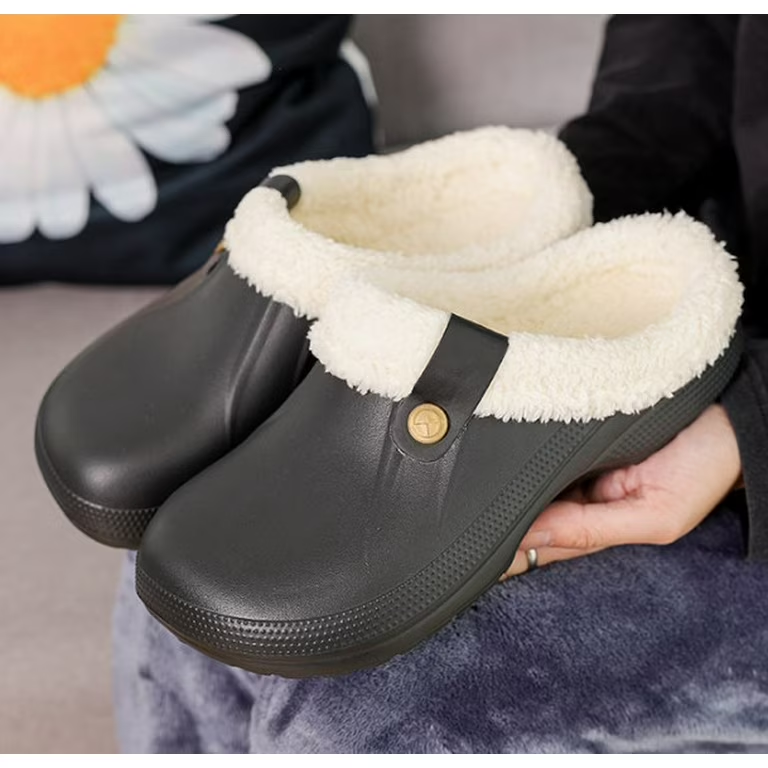As a buyer in the B2B space, specifically in the footwear niche, you need to make good decisions to grow your business and meet the demands of your market. One popular and growing product category you might consider is men’s outdoor slippers. Whether you sell to retail stores, online marketplaces, or specialized outdoor equipment suppliers, knowing the ins and outs of outdoor slippers can help you meet your customer’s needs and make more money.
In this article, we’re going to look at men’s outdoor slippers. As a buyer, we’ll talk about the product details, what’s happening in the market, and what you need to think about when you buy them in bulk. By the time you finish this article, you’ll know what you need to know to make a good decision and make money buying men’s outdoor slippers.

1. Why Focus on Men’s Outdoor Slippers?
Men’s outdoor slippers are not just a casual shoe. They are becoming more and more popular with men who like to be outside and still be comfortable. The trend toward more casual and practical footwear has made this a great category for you to consider.
Comfort and Versatility:
Outdoor slippers are designed to be worn inside and outside. They are versatile. Men are looking for shoes they can wear all day outside and then come home and wear them around the house.
All-Weather Usage
Today’s outdoor slippers for men often have durable soles and are made from weather-resistant materials. They are made to be worn in all kinds of weather—rain, cold, and even light trekking.
Growing Market Demand
The global slipper market has seen a steady increase in demand, especially since the pandemic. People want comfort. They want to be comfortable in their own home. They want to be comfortable when they go outside. The outdoor slippers segment is expected to continue to grow as men look for practical and stylish options for outdoor use.
2. Key Features to Consider

As a B2B buyer, you need to know what to look for in outdoor slippers so you can buy a quality product your customers will love. Here’s what you need to know.
Durable Sole Materials
The soles should be made of rubber or some other kind of non-slip, durable material that provides good traction on uneven surfaces. This is important for outdoor use so people don’t slip and fall, especially if the ground is wet or uneven.
Waterproof and Weather-Resistant
Look for slippers made with waterproof or at least water-resistant materials like synthetic leather, neoprene, or mesh. People who wear outdoor slippers want waterproof slippers, especially if they live in an area where the weather is unpredictable.
Insulation and Breathability
Depending on your market, you may want to carry insulated slippers for people who live in cold-weather climates and breathable slippers for people who live in warm-weather climates. Insulated slippers with faux fur or fleece linings are great for the winter months. Lightweight mesh slippers are perfect for the warmer months.

Easy Slip-On Designs
Men love outdoor slippers because they’re easy to put on and take off. Look for slippers with elastic openings, Velcro straps, or backless slip-on designs that make it easy for them to put on and take off their slippers while still keeping them secure.
Ergonomic Design
Many brands offer slippers with arch support and cushioned footbeds for added comfort. These features are especially important for men who are going to be on their feet for long hours outdoors. This is an opportunity for you to differentiate your product from the competition.
Style and Aesthetic Appeal
While the functionality of outdoor slippers for men is important, so is how they look. Think about what looks good in an outdoor slipper for men. Earth tones, camo prints, minimalist designs, branding, personalization, and other outdoor aesthetics are all things men look for in outdoor slippers.
3. Key Materials in Manufacturing

As a slipper manufacturer, you need to know what materials are used in the production of men’s outdoor slippers. This is important for quality control and cost management. The materials you use impact the production process, the durability of the slippers, the comfort of the slippers, and how well you can sell the slippers.
Upper Materials
The upper part of men’s outdoor slippers can be made from synthetic materials like neoprene or mesh. Neoprene is a synthetic rubber that is waterproof. Mesh is a synthetic material that is breathable. You can also use leather, suede, or faux leather for the upper part of men’s outdoor slippers. Leather and suede give the slippers a more rugged or stylish look, and they’re also weather resistant.
Sole Materials
The sole of men’s outdoor slippers can be made from rubber, thermoplastic rubber (TPR), or EVA (ethylene-vinyl acetate). Rubber, TPR, and EVA are lightweight materials that are also very durable. Rubber is great for traction and waterproofing. EVA is shock absorbent, so it’s great for more cushioned and comfortable outdoor slippers.
Lining and Insulation
For colder climates, you can use fleece, wool, or faux fur linings to provide insulation and keep feet warm. For warmer climates, you can use moisture-wicking fabrics to help keep feet cool and dry.
4. Top Considerations for Bulk Purchases
When you’re buying men’s outdoor slippers in bulk for your business, there are a few things to think about that can help you make your decision.
Market Demand and Seasonality
Outdoor slippers have seasons when they are in demand. For example, people buy hiking-style slippers in the spring and fall. People buy insulated slippers in the winter. Make sure you’re buying your slippers at the right time of year so you can meet your customers’ needs and not have a bunch of extra stock on hand.
Sourcing and Supply Chain
Building relationships with reliable suppliers is important to ensure you have a steady supply of high-quality slippers. As a buyer, you need to think about the lead time for your orders, the cost of shipping, and the supplier’s production capacity, especially during peak seasons.

Customization and Branding
Many B2B buyers like to have their own private label products or custom designs. Make sure your supplier can do things like put your logo on the slippers, use your unique color palette, or package the slippers in a way that is consistent with your retail brand.
MOQ (Minimum Order Quantity)
You need to know what the supplier’s MOQ is so you can plan your budget. Sometimes you can get a better price if you buy more, but you need to make sure you can sell the minimum quantity they require and that it makes sense for your business.
Quality Control
Doing quality inspections or working with suppliers who guarantee the durability and functionality of their slippers can save you time and money in the long run. If you’re buying from overseas, you might want to partner with a local inspection agency to help you make sure the quality of your products is up to par.

5. Know Your Competition
The outdoor slipper market is a competitive space with many manufacturers and brands. As a buyer, you need to do a competitor analysis to see what your competition is selling and to find any gaps in the market.
Popular Brands and Products
Research the brands that are popular in your area or target market. Look at their best-selling products, how they price them, and what their customers are saying. Look for patterns in the market, such as specific materials or features that people are buying.
Differentiation
To differentiate yourself, consider offering slippers with unique features or targeting niche markets like eco-friendly outdoor slippers or slippers designed for specific outdoor activities like fishing, hiking, or camping.
Pricing Strategies
Pricing is important, especially if you’re selling to other businesses. Depending on your positioning, you can sell premium, mid-range, or budget outdoor slippers. This will affect your profit margins and sales volume. You might also be able to negotiate flexible payment terms with your supplier to help you be more profitable.

6. Sustainability Considerations in Outdoor Slippers
Sustainability is a big deal for businesses and consumers. People are looking for eco-friendly materials and sustainable practices in how you make your outdoor slippers.
Eco-Friendly Materials
You might want to consider sourcing materials like recycled rubber, organic cotton, or biodegradable synthetics for your outdoor slippers. These will appeal to people who want to buy eco-friendly products and may allow you to charge a premium for your slippers.

Manufacturing Practices
You might want to look for suppliers who use sustainable manufacturing practices. For example, they might reduce water usage, minimize waste, and use renewable energy. You might also look for suppliers who have sustainability certifications like ISO 14001 or GRS (Global Recycle Standard).
Longevity and Durability
Providing slippers that last a long time and are durable is not only what people expect, but it also helps with sustainability. People don’t have to throw them away and buy new ones, which is good for the environment.
7. Logistics and Shipping Considerations
When you’re buying outdoor slippers in bulk, logistics is a big deal because it affects your bottom line. You need to understand how shipping works, how much it costs, and how long it takes to get your slippers.
Shipping Methods
You need to figure out the best and most cost-effective way to ship your slippers based on where you are and how fast you want them delivered. Air freight is faster but more expensive. Ocean shipping is cheaper for larger orders but takes longer.

Import Duties and Regulations
Make sure you understand the import duties, taxes, and compliance regulations in the market where you’re selling your outdoor slippers. This is especially important if you’re selling to people in other countries.
Packaging
You need to package your outdoor slippers properly so they don’t get damaged in transit. You might want to think about using eco-friendly packaging because that’s a trend right now. You might also want to think about how you can make your packaging as small as possible to save on shipping costs.
8. Conclusion
As a B2B buyer, you have a great opportunity to sell men’s outdoor slippers to a growing market. If you find the right supplier, use high-quality materials, and understand what people want, you can make a lot of money selling outdoor slippers.
Make sure you focus on things like durability, comfort, and seasonality to meet people’s needs. Also, think about things like sustainability and customization to help you stand out from your competitors in a crowded market. By building relationships with good suppliers and buying the right stuff at the right time, you can make a lot of money selling men’s outdoor slippers.


